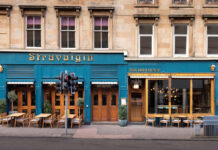Global gallery founders put their own stamp on The Fife Arms

ART takes centre stage at The Fife Arms in Braemar, which has reopened following a major restoration and refurbishment programme.
Owners Iwan and Manuela Wirth, art dealers and co-founders of global gallery Hauser & Wirth, have put their own stamp on the 19th century property in a project which spanned more than two years.
The new-look Fife Arms, which opened its doors last month, is now said to be home to more than 12,000 pieces of art, antiques and objects; works include commissions by international artists as well as Scottish artworks collected for the hotel.
Designed by Russell Sage Studio, the interiors of the 46 rooms and suites and public areas, which include the Clunie Dining Room, Elsa’s Bar, a library, drawing room and public bar The Flying Stag, have been influenced by Braemar and the surrounding area.


Each bedroom and suite is said to feature “one-of-a-kind furnishings and décor, each one a homage to a place, person, event or activity integral to the life and legacy of Braemar”; celebrated figures include Robert Louis Stevenson, who is said to have begun writing Treasure Island whilst on holiday in Braemar, and Lord Byron, who spent some of his childhood at a farm near Ballater with his Scottish mother.
The Fife Arms also has its own specially-designed ‘house’ tartan and tweed, which adorns the walls of the drawing room and the snug in The Flying Stag respectively.
Designer Russell Sage said: “Staying at The Fife Arms should feel like inheriting your own amazing Scottish baronial home, stuffed full of authentic, interesting and eccentric finds of the local area, with the most amazing art collection you’ve ever seen.”




























